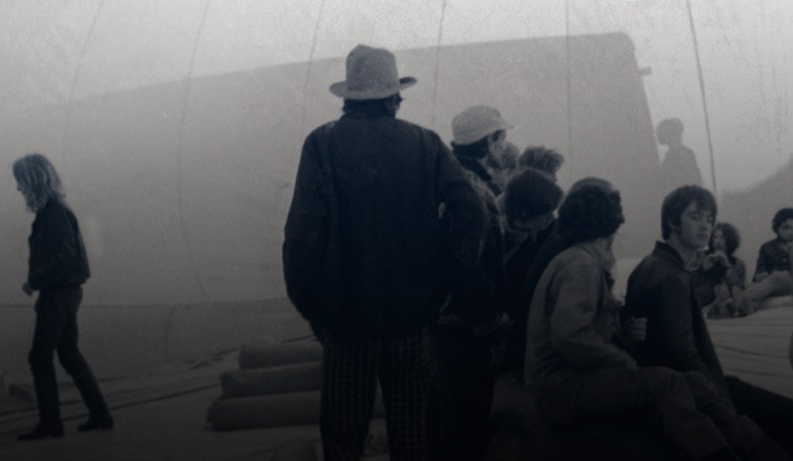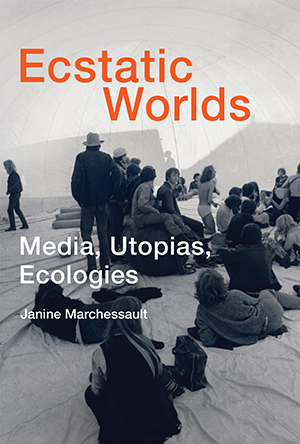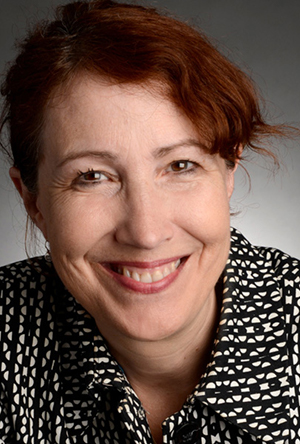
Janine Marchessault: Ecstatic Worlds: Media, Utopias, Ecologies
Thurs. Dec. 7, 2017
7:30 PM
Janine Marchessault interviewed by Marc Glassman with films by Morley Markson, Leslie Supnet, Zachary Finkelstein and special performance film by Martin Heath.
In Ecstatic Worlds, Janine Marchessault examines a series of utopian media events that opened up and expanded the cosmos, creating ecstatic collective experiences for spectators and participants. Join us for the launch of Ecstatic Worlds, featuring a conversation with Pages UnBound Director Marc Glassman, and screenings of March 31. (Dir Morley Markson, 10 min), In Still Time (Dir Leslie Supnet, 2017, 15 min), Point of No Return (Dir Zachary Finkelstein, 2016, 10 min), and a special performance film by Martin Heath.

Janine Marchessault
Ecstatic Worlds: Media, Utopias, Ecologies
Book Cover

Janine Marchessault
Janine Marchessault Marchessault is Professor of Cinema and Media Studies in the Department of Cinema and Media Arts at York University in Toronto.
Ecstatic Worlds
Postwar artists and architects have used photography, film, and other media to imagine and record the world as a wonder of collaborative entanglement-to translate the world for the world. In this book, Janine Marchessault examines a series of utopian media events that opened up and expanded the cosmos, creating ecstatic collective experiences for spectators and participants.
Marchessault shows that Edward Steichen's 1955 “Family of Man” photography exhibition, for example, and Jacques Cousteau's 1956 underwater film Le Monde du silence (The Silent World) both gave viewers a sense of the Earth as a shared ecology. The Festival of Britain (1951)—in particular its Telekinema (a combination of 3D film and television) and its “Live Architecture” exhibition-along with Expo 67's cinema experiments and media city created an awareness of multiple worlds. Toronto's alternative microcinema CineCycle, Agnès Varda's 2000 film Les Glaneurs et la glaneuse, and Buckminster Fuller's World Game (geoscope), representing ecologies of images and resources, encouraged planetary thinking. The transspecies communication platform, the Dolphin Embassy, devised by the Ant Farm architecture collaborative, extends this planetary perspective toward other species; and Finnish artist Erkki Kurenniemi's “Death of the Planet” projects a postanthropocentric future
Drawing on sources that range from the Scottish town planner Patrick Geddes to the French phenomenologist Maurice Merleau-Ponty, Marchessault argues that each of these media experiments represents an engagement with connectivity and collectivity through media that will help us imagine a new form of global humanism.
Endorsements:
“An unequalled historical sleuth and storyteller, Janine Marchessault shows that since the mid-twentieth century, experiments across audiovisual media have modeled a cosmic eco-consciousness both joyful and responsible. In the networks of inspiration and support among inventors, artists, designers, philosophers, and the industries and institutions that supported them, Marchessault reveals ecosystems that are as deep, fascinating, and delicately intertwined as a coral reef.”
—Laura Marks, Grant Strate University Professor, Simon Fraser University; author of Enfoldment and Infinity: An Islamic Genealogy of New Media Art and Hanan al-Cinema: Affections for the Moving Image
“Ecstatic Worlds returns to Karl Mannheim's utopian thought and Georges Bataille's ecological vision to multiply the potentials of Earth, globe, planet, and (crucially) the plurality of worlds that are imagined in the period following World War II. Marchessault offers compelling readings of experimental cinema and media artists from Jacques Cousteau to Buckminster Fuller whose world-making projects sharpen our understanding of images and media as key features of the current twenty-first century environment.”
—Patrick Jagoda, Associate Professor, University of Chicago
Films:
March 31. (Dir Morley Markson, 10 min)
March 31. Filmed by Morley Markson with Meyer Gassner at the controls of the TV receiver: 10 minutes of electronic drama generated by overriding tv's talk and action. A segment of a program Markson presented at the Toronto Art Gallery in 1968: The Electric Family, 6 screens compressing and magnifying the invisible electronic media surrounding us, penetrating us. Recently redigitized, it is a reflection on the chaosmus of our electronic consciousness, the invisible environment which we produce and within which we swim, deep-sea divers all.
In Still Time (Dir Leslie Supnet, 2017, 15 min)
Still Time is an experimental animation that investigates the catastrophic image, repurposing media from the net of the Syrian war. This spectral work focuses on the collective (in)ability to bear witness and complicity in the violence being documented. How can trauma be properly represented? How do we give meaning to an event that disrupts time?
Point of No Return (Dir Zachary Finkelstein, 2016, 10 min)
Under a microscope tiny shard of ice loom large as glaciers. Using microscopic videography and polarizing lenses, Point of No Return is a visually stunning study of melting ice in real time. The film provides a micro perspective on climate change, a massive but incremental global event that is usually imperceptible in our day to day lives. With narration in eleven of the most widely-spoken languages in the world, Point of No Return presents a dialogue in abstraction between emotional understanding and scientific fact in the face of rising global temperatures.
Martin Heath, special performance film shown on hand-cranked 35mm projector.
